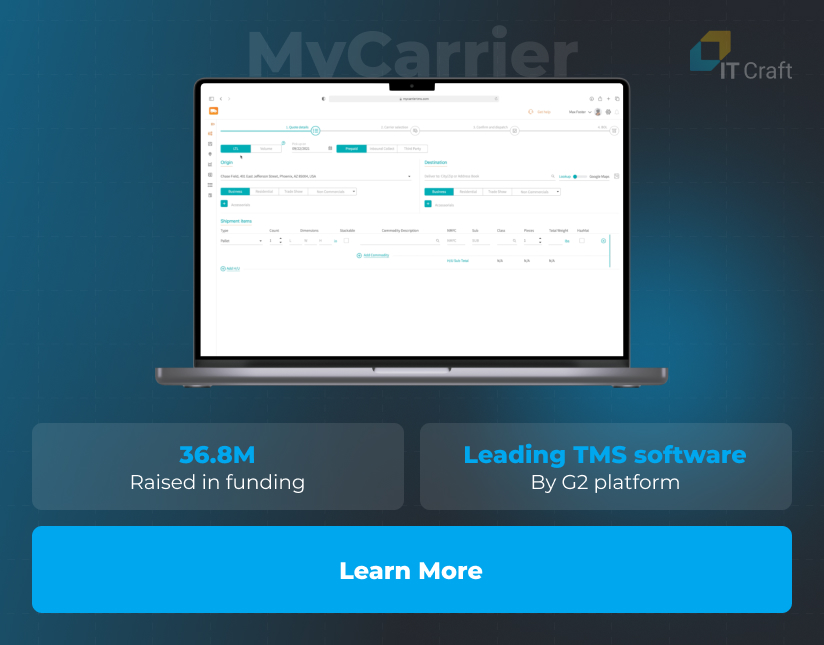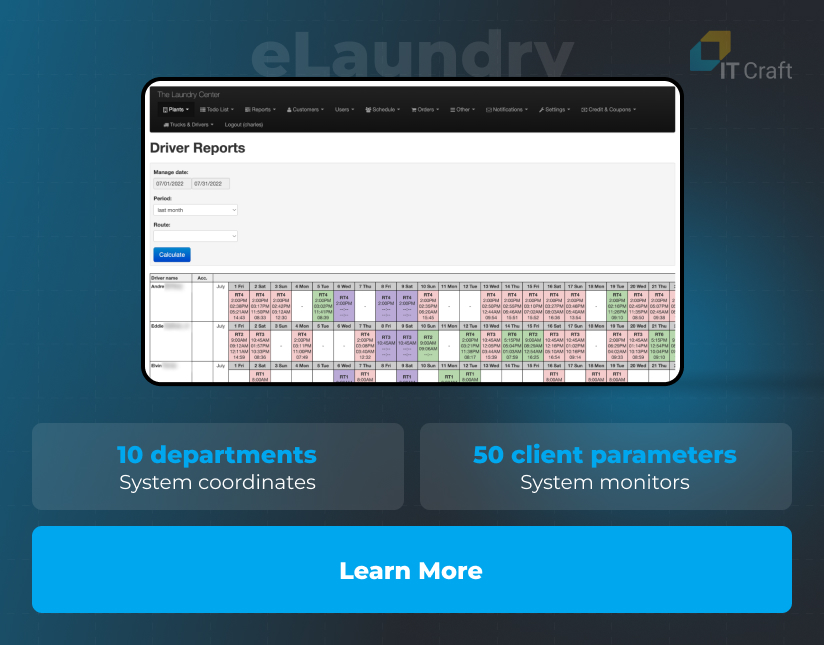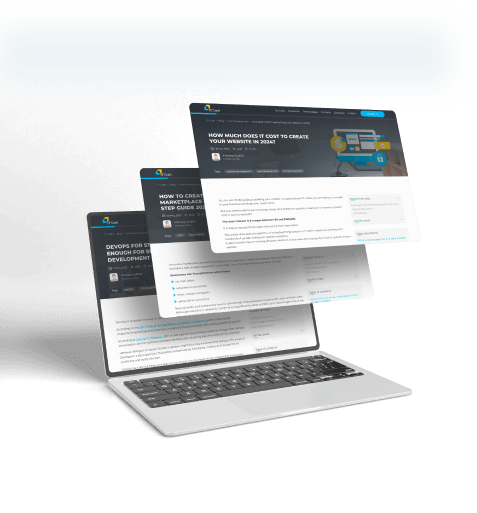Logistics software development is a crucial part of supply chain optimization in a world where deliveries happen every second.
Companies must incorporate improvements quickly into their digital processes. Otherwise, little mistakes accumulate with disappointing results for both their customers and the companies themselves.
For instance, a third of businesses have sold items out of stock, resulting in delayed deliveries and lost customers. 25% of those customers who did not receive their order on time reported they would walk away and never return.
Let’s discuss the key considerations of optimization in supply chain management and how the right software implementation helps.
1
What is Optimization in Supply Chain Management?
Optimization means a company’s continuous adjustment to the changing environment, which is critical to its resilience.
Supply chain optimization means the correct application of delivery processes: the company delivers the correct items to the right place on time and at a reasonable cost.
Sales managers process clients’ orders more effectively. All necessary information about the order is available instantly at all steps.
2
What is the Importance of Supply Chain Optimization?
Maintaining an optimized supply chain is key in highly competitive markets. Effective operations are essential to keeping pace with developing competitors and changing customer needs.
Businesses address the following challenges with the help of optimization:
Surging costs
Logistics businesses face declining margins due to rising costs and high inflation rates. They must eliminate inefficiencies and cost leaks to provide efficient services and competitive prices.
Labor shortage
Shortage of qualified labor force tops the list of concerns composed by supply chain leaders. Companies investing in supply chain management optimization create more rewarding supply jobs, raising interest among the industry’s top talents.
Sustainability
Efficient supply chain management is essential for coping with uncertainty, emerging gaps, and disrupting challenges. Companies need to increase transparency and ensure suppliers’ compliance for sustainable results.
Fulfillment accuracy
Time to consumers makes the difference between business growth and decline. However, fast order fulfillment is possible with a growing accuracy across the entire supply chain, which stems from optimization.
Growing complexity
Only 30% of executives believe their strategy and operations are aligned as they have to, which is no surprise. Companies must orchestrate a growing number of operations across the entire supply chain for efficient order execution.

3
Benefits of Supply Chain Optimization
Supply chain management optimization requires a substantial amount of time and resources. But it always pays off.
For instance, businesses using a TMS can reduce freight expenses by 8%, according to a G2 report. And this is only one of many points where supply chain optimization increases the bottom line!
Further benefits of supply chain optimization include:

Productivity boost
Collaboration improves when a company streamlines operations, aligns the efforts of different departments and increases the visibility of single operations across the system. The team reduces the number of issues that occur and prepares precise schedules.
Agility
Simplified supplier onboarding and collaboration are needed for the company’s flexibility. An agile company requires fewer resources to evaluate and manage new suppliers. It reacts faster to emerging opportunities.
Increased resilience
Management software analyzes supplier relationships: manage agreement terms, identify gaps, or consider relationship prioritizing. Companies become less prone to emerging risks and challenges.
Customer loyalty
To meet the rising bar of customer expectations, positive internal improvements must be part of the plan. They have a direct impact on customers’ decisions.
Competitive advantage
Unique, efficient processes supported by a custom software solution enable companies to take a different position, offering features other companies do not and raising interest from prospective clients.
Reliable forecasting
Historical and real-time data-based reports increase planning accuracy. The company can forecast customer demand, production or delivery time, keep optimum inventory levels, and more.
Increased profits
The end goal of supply chain optimization is profit growth. Companies achieve it by reducing operational costs and growing customer demand.
A transparent spending structure enables companies to identify improvement areas and streamline operating expenses. Reducing supply chain costs from 9% to 4% doubles a company’s profits.
4
Supply Chain Optimization Strategy
Apart from costs and ROI concerns, the biggest obstacle to optimizing a supply chain is identifying where to start.
Risks are high. Complex, sophisticated processes can deteriorate immediately when software implementation is based on a wrong vision.
As a decision maker, you need to go through three phases to prevent possible breakdowns and focus on positive impact:
Design
Describe current processes. Identify cost leaks and inefficiencies that you will eliminate during supply chain planning optimization:
One—meet clients’ expectations that traditional and online ordering are equally fast and convenient.
Two—optimize the company’s supply chain so that it is transparent, cost-effective, and resilient against emerging challenges.
Modules: data analytics, resources and planning, automation
Planning
Create a strategic improvement plan. Divide it into practical steps, targeting inefficiencies at each specific point, from raw materials to return management. It includes required stock levels, supply diversification, warehouse layout, route planning, and more.
Increase visibility and coordination between single points by understanding the essential role of warehouse management system in optimizing these processes.
Modules: workforce management, procurement management, customer relationship management
Execution
Integrate new features into the company’s ERP system or improve existing functionality. Launch a standalone app connected to the software system via an API when diversified roles and third-party access are required.
Retain flexibility during the execution phase: make timely adjustments when user feedback suggests it.
Consider a cloud system. Managers process clients’ orders more efficiently across the entire chain while all necessary information is available immediately from any employed device.
Modules: transportation management, inventory management, order management
Optimization in supply chain management is as complex as a company’s processes. The following modules enhance ongoing processes:
Key ERP modules

You must implement the required ones. Based on your specifics, you might not need some modules, e.g., manufacturing, and make the others your next priority, e.g., customer relationship.
Make an early decision. The design stage is the best time to decide which of the above modules you need for a successful supply chain optimization.
5
Ten Tips for Optimizing Your Supply Chain Process
Supply chain optimization requires careful improvement on multiple levels, being a mission-critical task. Here are key tips for improving the supply chain:

Tip 1. Focus on the long term
As a business, you must attain long-term sustainability, which is challenging. According to a McKinsey study, only 12% of 56% of organizations that started transformation reached sustainable results for 3+ consecutive years. However, those few achieved 200% revenue growth compared to those who did not.
Top performers use a combination of these three key elements:
- Maintaining implementation rigor at later stages.
- Upgrading and promoting talents.
- Investing in the right resources.
Tip 2. Remember cultural differences
Tight collaboration with suppliers, clients, manufacturers, and service providers is crucial for optimizing supply chain management.
For success, you must keep in mind a variety of cultures and best practices: company, industry, regional, national, and more.
You must manage expectations appropriately to remove invisible communication barriers between you and your partners.
Tip 3. Maintain standards
Clear internal standards, unambiguous onboarding criteria, and measurable KPIs are essential for breaking entry barriers that potential suppliers and prospective clients might face.
Think of developing specific templates and integrating them into your software to track single parameters and properly segment both partners and clients with minimum effort on your side.
Tip 4. Develop an ecosystem
Expanding your software to an ecosystem can make a difference for your partners, eliminating friction across the supply chain.
Think of your business as a software company. Provide fast onboarding and seamless data exchange with partners’ software through API integrations. Think of a special portal containing available resources and documentation. Foster a community.
Tip 5. Reach 100% visibility
72% of companies cannot respond to a breakdown timely due to a supply chain’s limited visibility. They consider lack of transparency a “black hole” that costs profits and decreases partners’ loyalty.
Join the remaining 28%. Build a visible order management system with a focus on resilience. This lets you monitor processes and identify issues before they grow too big.
Tip 6. Upgrade to real-time execution
Real-time order execution is a natural upgrade of a 100%-visible supply chain. It closes the gap between a decision and its execution.
Only 7% of supply chain organizations have a real-time execution system. Yet, they never regret this investment. A real-time execution system enables them to react to changing conditions immediately, thus greatly contributing to supply chain optimization.
Tip 7. Reduce manual processes
Automation enables a company to streamline processes, redistribute workload, and prevent burnout from doing routine tasks. You need no aggressive hiring policy for operations scaling.
Focus on a precise definition of business processes. Introduce improvements step by step. Ensure your team and partners need minimum learning time to start using automation.
Tip 8. Prioritize security
Breaches are catastrophic for logistics companies. They cost organizations over $9.44m on average. Such huge sums arise from lost data, service downtime, employees’ idle time, and regulatory fines.
A successful attack can quickly affect all participants of a supply chain.
You need to identify risks, introduce best security practices across the entire supply chain, e.g., DevSecOps and zero-trust infrastructure, and monitor emerging threats.
Tip 9. Invest in forecasting
Building a demand forecasting system is crucial for supply chain management optimization.
You make data-based decisions. You prevent situations when a warehouse suddenly runs short of stock and the company faces fines for delivery delays.
Certainly, forecasts cannot be 100% accurate. This is why companies prefer adding AI-based functionality that can correct prediction errors.
Tip 10. Do regular audits
Supply chain optimization is a continuous activity.
Schedule system audits for at least every six months. Compare plans and outcomes to introduce further adjustments. Identify possible disruptions to allow preparation time.
Regular penetration testing should also be conducted to identify security concerns. Fix vulnerabilities immediately. Examine your suppliers’ adherence to high security standards.
6
Five Models of Supply Chain Management
Optimization in the supply chain looks different for each business.
Businesses can apply different supply chain management models depending on goals, size, risks, and used software.
Several models exist to cater to different companies’ needs for a smooth flow at the lowest costs. Let’s analyze the most common five:

Continuous flow
This traditional model focuses on producing and moving one item at a time as continuously as possible and with little variation.
The continuous flow model loses effectiveness when demand and supply fluctuate, or constant customizations are required. However, it lets businesses reach the best productivity in a stable environment and, as a result, low product prices.
Fast supply chain
A fast supply chain focuses on getting a finished product to the market immediately. The companies aim to maximize returns with their help.
This model works best for companies with short product lifecycles. Trendsetters receive a competitive edge by updating and selling their products before demand declines.
Efficient chain
An efficient chain model works best for businesses where customer choice is mostly based on the product price. Businesses focus on optimum asset utilization and supply chain to offer the best price.
Businesses use this model to attain a high level of end-to-end effectiveness while operating in markets with severe competition.
Agile supply chain
An agile supply chain focuses on fulfilling special orders after businesses receive them from customers rather than selling already-produced items.
Businesses require extra capacity and flexibility to manage large orders and small batches equally effectively. Yet, an Agile supply chain enables businesses to cope successfully with unpredictable market demand.
Custom configured
Companies can combine elements from several models to create a supply chain for their goals. Usually, the custom-configured model combines characteristics of continuous and Agile models when both end-to-end production and additional customization are necessary.
The custom-configured model requires an extra initial investment and is complex to scale. However, it works best for small batches and fast turnaround.
7
Success Stories
Here are some examples of how IT Craft helps companies build custom solutions for supply chain optimization:
MyCarrier: building a TMS that meets the market’s long-term demands
MyCarrier TMS eliminates inefficiencies when managing truckloads. It connects shippers and their customers, enabling both parties to make fully visible deliveries.
The IT Craft team developed an MVP from scratch, staying within the client’s time and budget limits. User interest skyrocketed, proving the market demand for the product.
The development team continued working on product expansion and transformation. The Agile approach enabled the team to deliver new features flexibly, helping the client respond quickly to changing user needs.
Software transition to the cloud has increased scalability and stability. The introduction of CI/CD ensures faster feature updates.

eLaundry: increasing service level through process visibility
Initially, the client had an unfinished software system. He wanted to manage on-demand laundry services for regular customers in Manhattan with its help. The IT Craft team took over the client’s project, improving, finalizing, and expanding the available system.
The same dedicated team helped the client with digital transformation once they decided to focus on business customers, such as cafés, restaurants, and hotels.
The system enables the complete visibility of employed processes. It processes data in real-time and sends notifications to responsible managers if fluctuations emerge.
The business owner can track the revenue margins of each order and identify improvement areas.
The client achieves high efficiency and an exceptional level of provided services.

FieldOne: transforming worn-out software into a cloud solution
FieldOne system improved coordination between field technicians and office managers, improving business processes inside service companies.
The project once started as desktop software. It was losing its competitive edge after the mass adoption of smartphones and tablets. The IT Craft team initially took over software maintenance. However, it switched to software transformation needed to get the client’s project back on track.
IT Craft engineers used the cross-platform approach to app development. This provided optimum value and ensured concurrent updates on all mobile platforms.
The team completed seamless integrations with multiple systems for seamless data exchange. Special emphasis was on app security and user data protection.
Eventually, Microsoft acquired the FieldOne system to increase its own bottom line.

!
Conclusion
Now is the best time for your company to adapt to disruptive trends by focusing on key priorities and leveraging tailored logistics software development solutions to support long-term goals.
Focus on the most important parts of your supply chain optimization plan:
- Prioritize efficiency and resilience.
- Identify risks and opportunities.
- Improve coordination.
- Increase visibility.
- Work on your long-term goals.










